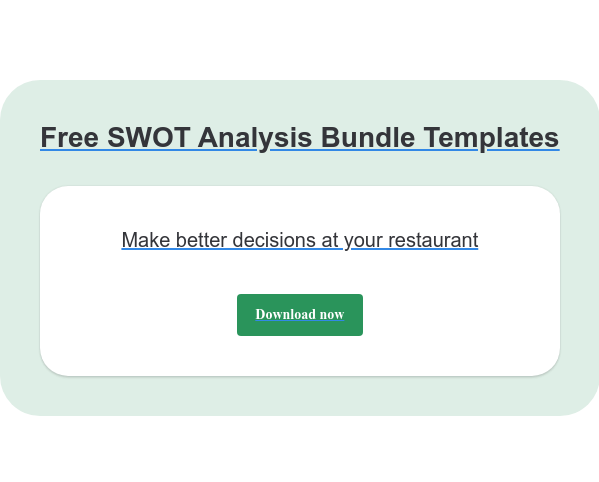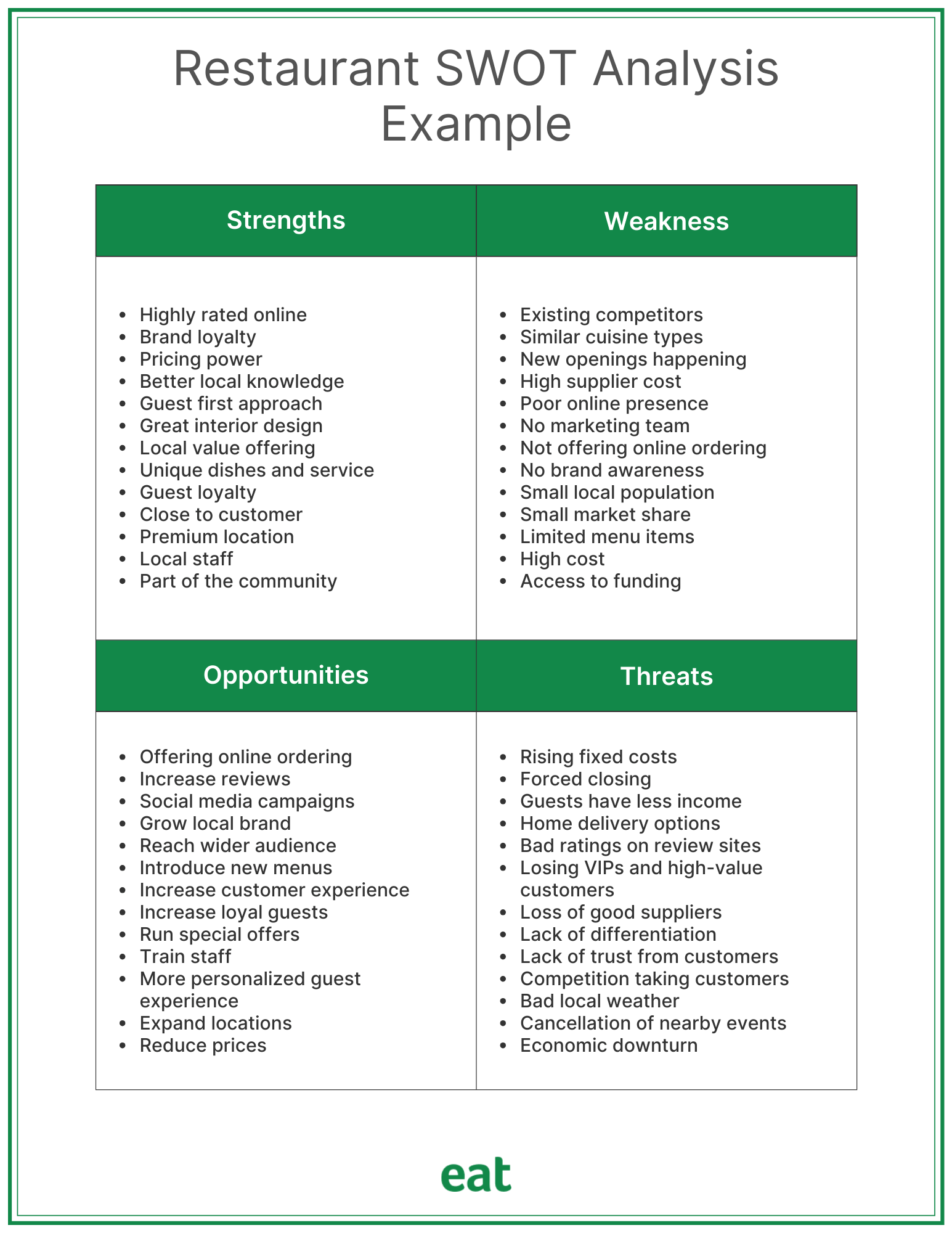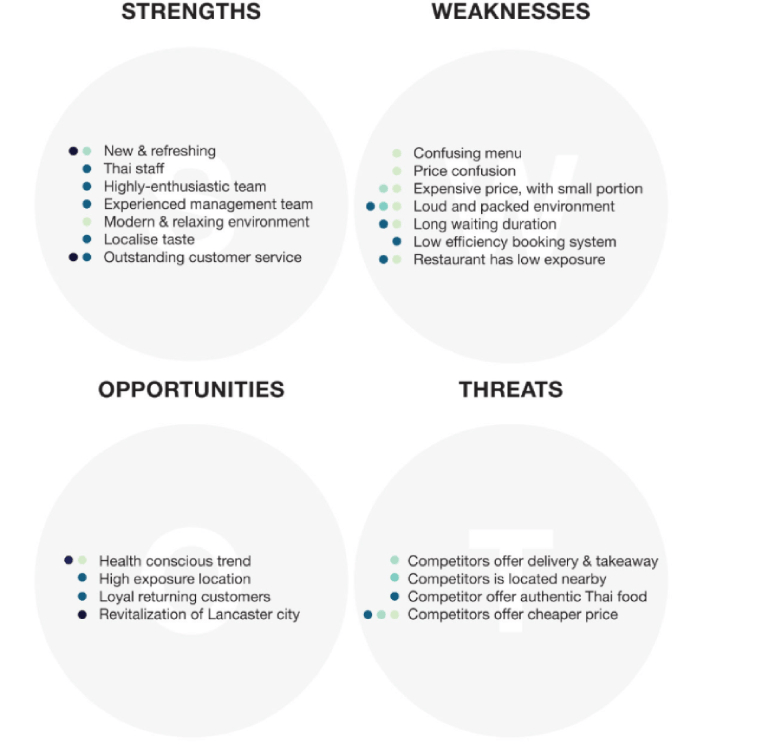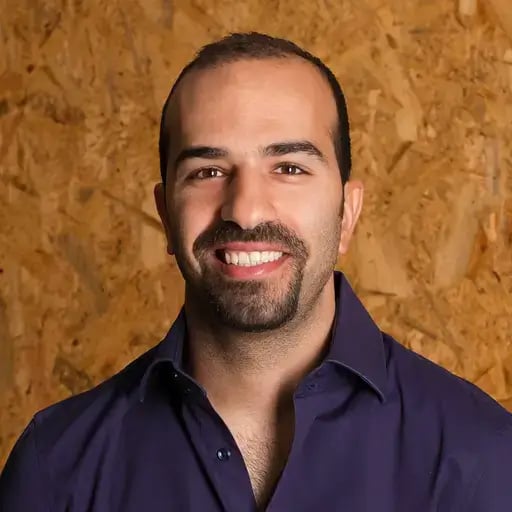Your restaurant may have the best ambiance or serve the most delicious appetizers in your neighborhood, but if you don’t monitor its strengths and weaknesses or identify the opportunities and threats facing your business strategy, your profitability will suffer.
This is where conducting a SWOT analysis for a restaurant can be a useful tool for your best defense against losing ground to your competitors.
In this blog, we’ll guide you through the steps of conducting a SWOT analysis, with insights customized for various dining establishments, including casual dining restaurants, to highlight how this process can work for your business.
Key Takeaways
-
SWOT analysis stands for Strengths, Weaknesses, Opportunities, and Threats, and is a strategic tool used by restaurants to assess their internal and external factors.
-
Strengths: These are the positive aspects of a restaurant, such as a strong brand image, loyal customer base, unique menu, excellent service, and efficient operations.
-
Weaknesses: These are the areas that need improvement in a restaurant, such as poor customer service, outdated décor, limited menu options, high food costs, and low employee morale.
-
Opportunities: These are the external factors that could benefit a restaurant, such as new market segments, expanding to new locations, introducing new menu items, utilizing technology, and collaborating with local businesses.
-
Threats: These are the external factors that could negatively impact a restaurant, such as intense competition, changing consumer preferences, economic challenges, regulatory changes, and negative online reviews.
-
It's important for restaurants to regularly review and update their SWOT analysis to stay proactive and adapt to changing market conditions.
Further reading
A restaurant SWOT analysis is an exercise you can go through at your restaurant business to analyze your:
- Strengths
- Weaknesses
- Opportunities,
- and Threats.
Usually, a SWOT analysis is visually displayed in a matrix format. The upper row outlines strengths and weaknesses in this layout, while the lower row highlights opportunities and threats. Internal aspects, such as strengths and weaknesses, find a place in the top row, whereas external factors, like opportunities and threats, are featured in the second row.
Here’s an example:
.png?width=640&height=430&name=Creating%20a%20Visual%20for%20SWOT%20Analysis%20in%20Restaurants%20-%20visual%20selection%20(2).png)
This strategic planning tool facilitates a comprehensive examination of both internal factors and external elements, aiding businesses in strategic decision-making.
TIP: A free restaurant SWOT analysis template is available to easily categorize their strengths, weaknesses, opportunities, and threats.
Why is a restaurant SWOT analysis important?
A restaurant SWOT analysis is a versatile tool that helps you understand where your business stands. Highlighting strengths like a skilled team, unique menu items, or a prime location, it shows what sets you apart. At the same time, it encourages you to plan for challenges, so you’re better prepared to tackle them.
While often part of a business plan or marketing strategy, a SWOT analysis is just as valuable whenever you’re making key decisions for your restaurant.
How to conduct a restaurant SWOT analysis?
Conducting a restaurant SWOT analysis is not too difficult. The most efficient way to go about putting one together is with the help of your restaurant team (everyone from upper management to front-of-house staff).
You can do this in a group or speak to each individual separately - but ultimately you want to ask them directly what they think are your restaurant’s strengths, weaknesses, opportunities, and threats.
Need a hand with that? Let’s walk you through the steps.
Your guide to conducting a restaurant SWOT analysis:
- Start with research: Gather insights about your restaurant by checking online reviews, asking guests for feedback, or using surveys.
- Note the positives: Daily, jot down when customers seem happiest, employees excel, or operations run smoothly.
- Identify areas for improvement: Consider why some customers are unhappy or why certain staff struggle.
- Study the competition: Compare your strengths and weaknesses with other local restaurants and explore opportunities like upcoming events.
- Create a SWOT analysis: Involve your team to list strengths, weaknesses, opportunities, and threats. Use examples like McDonald's for guidance.
- Develop a strategy: Use your SWOT to enhance strengths, address weaknesses, seize opportunities, and prepare for threats.
.png?width=2116&height=1108&name=Your%20Guide%20to%20Conducting%20a%20Restaurant%20SWOT%20Analysis%20-%20visual%20selection%20(1).png)
Pro tip: To help you get to your goal faster, why not use an AI prompt?
Here’s a clear and actionable AI prompt for conducting a restaurant SWOT analysis:
I own a restaurant and want to conduct a SWOT analysis. Can you guide me step by step on how to identify my strengths, weaknesses, opportunities, and threats? Include practical examples relevant to the restaurant industry and tips for involving my team in the process.
Simply copy and paste.
Now, let's take a more in-depth look at how you can get started:
Brainstorm your strengths and weaknesses
Start by assessing all the strong points of your restaurant. What makes people choose YOU over others?
-
Is it the exquisite tapas lined up by your staff?
-
The creative seating arrangement?
-
Is your weekend special?
Things that make your restaurant stand out from others qualify as your strengths.
Other strengths might include how the menu is crafted, the variety of cuisines you offer, and your management team’s ability to attract a crowd with experiential marketing during those slow times.
The next step is to see what areas of your restaurant need improvement.
If you’re serving a dessert that isn’t getting great feedback or your chef isn’t very effective at managing his/her time, these are areas that need your attention. Employee turnover also has the potential to stunt a restaurant’s expansion.
Further reading
Identifying and addressing weaknesses is so important for a restaurant's success. Zeroing in on your negatives isn’t going to be a pleasant experience (no one likes to acknowledge their flaws), but getting those weak points out in the open is the only way to accept and overcome them.
Recognize your opportunities and threats
Recognizing opportunities and threats is a necessary step in the SWOT analysis process. Opportunities are external factors that can benefit your restaurant, while threats are external factors that can harm your restaurant.
To best identify these elements, consider the following:
-
Market Trends: Keep up with current trends and customer preferences to find opportunities. For example, rising demand for plant-based foods might inspire you to launch a vegan menu.
-
Competitor Analysis: Study competitors to spot ways to stand out. If a nearby restaurant has poor service, focus on promoting your exceptional customer care.
-
Customer Feedback: Use feedback to improve and exceed expectations. Trends like requests for gluten-free options can guide your menu updates.
-
Economic and Demographic Changes: Watch for shifts like population growth or new demographics. A surge in young professionals could be a chance to offer a trendy brunch menu.
Further reading
Okay, so you’ve done your homework. Now what? It’s time to start taking action using what you discovered about your restaurant and staff.
Implementing SWOT analysis findings is a big step in the strategic planning process. Once you have identified your restaurant’s strengths, weaknesses, opportunities, and threats, you can develop a strategic plan to address them effectively.
Here are some steps to implement SWOT analysis findings:
- Focus on Strengths: Use your strengths to achieve goals. For instance, if excellent customer service is your strength, highlight it in marketing and maintain it in daily operations.
- Fix Weaknesses: Address areas that need improvement. If service quality is an issue, invest in staff training.
- Seize Opportunities: Act on opportunities. For example, if sustainable food is trending, source locally and promote it in your campaigns.
- Tackle Threats: Counteract threats. If a competitor opens nearby, emphasize what makes you unique, like signature dishes or a welcoming atmosphere.
By systematically addressing each element of your SWOT analysis, you can create a powerful strategic plan that positions your restaurant for success.
Introduction to SWOT analysis
A SWOT analysis is a strategic planning tool used to evaluate a restaurant’s strengths, weaknesses, opportunities, and threats. It is a crucial step in understanding the current state of a restaurant business and making informed decisions to drive growth and success. In the restaurant industry, a SWOT analysis can help owners and managers identify areas for improvement, capitalize on strengths, and mitigate weaknesses.
By systematically examining these four elements, restaurant owners can gain a comprehensive understanding of their business landscape. This analysis not only highlights what the restaurant is doing well but also sheds light on areas that need attention. Whether you’re running a cozy local restaurant or a bustling fine dining establishment, a SWOT analysis is an invaluable tool for strategic planning and ensuring long-term success.
Understanding the basics
A SWOT analysis typically involves identifying the internal factors that affect a restaurant’s performance, such as strengths and weaknesses, and the external factors that can impact the business, such as opportunities and threats. By analyzing these factors, restaurant owners and managers can develop a comprehensive understanding of their business and make strategic decisions to drive success.
Internal factors include elements within the restaurant’s control, such as the quality of food, staff efficiency, and customer service. On the other hand, external factors encompass market trends, economic conditions, and competitive pressures. By distinguishing between these internal and external factors, restaurant owners can craft strategies that leverage their strengths, address their weaknesses, seize opportunities, and defend against potential threats.
Importance in the restaurant industry
In the restaurant industry, a SWOT analysis is essential for making informed decisions. The industry is highly competitive, and restaurants must continually adapt to changing consumer preferences, emerging food trends, and shifting market conditions. A SWOT analysis can help restaurants identify areas for improvement, capitalize on strengths, and mitigate weaknesses, ultimately driving growth and success.
For example, recognizing a growing trend towards plant-based diets can be an opportunity for a restaurant to introduce a new vegan menu. Similarly, identifying a weakness, such as slow service, can prompt a restaurant to invest in staff training. By staying attuned to both internal and external factors, restaurants can remain agile and responsive in a dynamic market, ensuring they meet and exceed customer expectations.
Benefits of SWOT analysis
A SWOT analysis offers numerous benefits to restaurants, including strategic advantages, improved decision-making, and enhanced competitiveness. By providing a clear framework for evaluating a restaurant’s current position, a SWOT analysis helps owners and managers make informed decisions that align with their business goals.
One of the primary benefits is the ability to identify and leverage strengths. For example, if a restaurant is known for its exceptional service, this strength can be highlighted in marketing campaigns to attract more customers. Additionally, by pinpointing weaknesses, such as high employee turnover, restaurants can take proactive steps to address these issues, improving overall operational efficiency.
Moreover, a SWOT analysis helps in recognizing growth opportunities, such as expanding into new markets or introducing popular menu items. It also prepares restaurants to tackle potential threats, like economic downturns or increased competition, by developing contingency plans. Ultimately, a well-conducted SWOT analysis equips restaurant owners with the insights needed to navigate the complexities of the food industry and achieve sustained success.
Developing a strategic plan
A strategic plan outlines your restaurant’s goals, objectives, and strategies for achieving them.
Including a SWOT analysis in your restaurant business plan is crucial for assessing the effectiveness of your strategies and adapting to market conditions.
Here’s how to create an effective strategic plan:
- Define Your Mission and Vision: Start by defining your restaurant’s mission and vision statements. Your mission statement should articulate your restaurant’s purpose and core values, while your vision statement should outline your long-term goals and aspirations.
- Set Goals and Objectives: Set specific, measurable, achievable, relevant, and time-bound (SMART) goals and objectives for your restaurant. For example, a goal might be to increase monthly revenue by 15% within the next six months.
- Identify Strategies: Identify strategies to achieve your goals and objectives. If one of your goals is to improve customer satisfaction, strategies might include enhancing staff training, revamping the menu, or improving the dining ambiance.
- Allocate Resources: Allocate resources, such as personnel, equipment, and budget, to support your strategies. Ensure that you have the necessary resources to implement your strategies effectively.
- Monitor and Evaluate: Monitor and evaluate your progress towards your goals and objectives. Regularly review your strategic plan and make adjustments as needed to stay on track.
Restaurant industry trends and insights
The restaurant industry is constantly evolving, with new trends and insights emerging all the time.
Here are some current trends and insights in the restaurant industry:
-
Rising Demand for Healthy and Sustainable Food: Attract health-conscious diners by offering organic, locally-sourced, or plant-based dishes.
-
Focus on Customer Experience and Loyalty: Build loyalty through personalized service, loyalty programs, and unforgettable dining experiences.
-
Popularity of Online Ordering and Delivery: Increase revenue with an easy-to-use online ordering system and delivery partnerships.
-
Competition from Meal Kits and Ghost Kitchens: Stand out by offering unique dining experiences and top-quality food that can’t be replicated at home.
-
Importance of Social Media and Marketing: Reach new customers by posting regularly, running targeted ads, and collaborating with influencers.
Staying informed about these trends can help you stay competitive and meet customer expectations.
Recognizing opportunities and threat
The opportunities part is where you think about all the external factors that can increase your sales revenue. By conducting a thorough analysis, you can identify growth opportunities that can help your restaurant expand and thrive in a competitive market.
Maybe it’s high time you introduced a separate menu for patrons who’ve adopted a vegetarian lifestyle or participated in a culinary event to reach new audiences.
A fine dining restaurant, for instance, might recognize different opportunities and threats compared to other types of dining establishments due to its focus on high-quality food, exceptional service, and distinctive menu offerings.
Another thing you can do is think of ways to expand or grow your existing presence. This could be something as simple as being active on Instagram or offering a deal or two during happy hours. These could be some opportunities you can capitalize on early to increase foot traffic to your restaurant.
- Email marketing
- Digital marketing
- Instagram ads
- Restaurant SEO
- Influencers
- Events
- Social media reservations
Finally, yet importantly, in the SWOT analysis you need the identify all possible external threats to your restaurant.
An example might be a new cuisine scheduled to be introduced by a restaurant in your neighborhood.
Even if you’re catering to the taste of a specific group of diners, this restaurant threatens your sales by giving everyone a new option come lunchtime.
There can be other potential threats as well, such as an increase in the price of the ingredients you regularly source, or an increase in the social media following of your closest competitor.
The more you stay vigilant about what could dampen your restaurant’s profitability, the better equipped you will be to put out the fire before it catches you off guard.
Here’s an example of a SWOT analysis done for an Asian-style seafood restaurant:

It’s easy to see that most of the things are more or less similar to what we’ve discussed in the strengths, weaknesses, opportunities, and threats sections.
Apart from a standard SWOT analysis, you could do a restaurant competitor SWOT analysis to identify where others may be surpassing you, as well as what leverage they have over your restaurant. We will go over how to conduct a restaurant competitor SWOT analysis further in this article.
 Restaurant SWOT analysis example
Restaurant SWOT analysis example
A good SWOT analysis is usually done on a four-square, grid-style table, with a bulleted list presented for each of its sections. Various restaurant SWOT analysis examples can illustrate the application of the SWOT framework across different types of restaurants, such as fine dining, cafes, and quick-service restaurants (QSR).
You can use Canva or another similar graphic design tool to create one for your restaurant. Alternatively, you can grab and customize one of the many pre-existing templates from the web.
The SWOT analysis examples below show what a typical restaurant industry SWOT matrix might look like.

How to conduct a restaurant competitor SWOT analysis?
When conducting a SWOT analysis, part of your energy could also be geared towards analyzing restaurants that are offering the same kind of food and prices as you are.
This is called a “Restaurant Competitor SWOT analysis” and is primarily geared at putting yourself in the shoes of competitor restaurants to make the same assessment you would towards your own business. With a restaurant competitor SWOT analysis, you can get actionable insights into what your competition is strong at and where you could do better.
When undergoing competitive research, ask yourself where your target audience would prefer to eat, and then analyze the strengths, weaknesses, opportunities threats to get a realistic picture of your market position in the competitive landscape.
Example restaurant competitor SWOT analysis for a French restaurant
Let’s use an example where your main competitor is a French restaurant located within a 5-mile radius of your location, the SWOT analysis can be done in a manner like this:
Strengths: Why do people dine at this restaurant instead of other French restaurants in the city? It could be because of the authentic taste of its meals or its ability to keep guests entertained.
Reading a couple of reviews on TripAdvisor or Google is a great way to know why patrons love visiting a specific restaurant.
Further reading
Weaknesses: Where does this restaurant struggle in comparison to others? It might be that its menu has just one option for vegetarians. Or perhaps it’s failing to engage millennial diners with a badly executed Instagram campaign.
Again, social media analysis and customer feedback are great resources to help you identify competitors’ weaknesses (which may highlight a new strength or two for your own restaurant).
Opportunities: What measures do you think this restaurant can undertake to improve its branding, widen its target market, and/or improve its operations? Maybe it just needs to revamp its menu to include a few more appetizers.
Whatever opportunities you uncover through a competitor SWOT analysis can be incorporated into your restaurant marketing strategy to enhance your strengths in related to your competitors.
Threats: These refer to the external factors that are beyond the control of your competitor and could place their profitability and turnover at risk.
For example, an economic downturn may have caused people to look for affordable French restaurant alternatives.
Threats are essential to keep tabs on because what’s threatening your competitor’s business could very well threaten yours as well.
Here’s what a restaurant competitor's SWOT analysis would probably look like if your main competitor were a Thai restaurant:

Project the restaurant competitor’s SWOT analysis against your own SWOT analysis table to see what needs to be changed and what you can do to boost your business ahead.

Final verdict
A restaurant SWOT analysis can help you get a firmer hold on where you excel and which areas of your restaurant need attention.
It can lead you to a previously untapped market or help you identify roadblocks that could hinder your productivity. As you reaffirm your industry positioning, use it to build a solid foundation and let the rest fall into place.
Frequently asked questions about restaurant SWOT analysis
Where can I get a free SWOT analysis template?
To download a free template for a restaurant SWOT analysis or a restaurant SWOT analysis guide, click here. Make better decisions at your restaurant with our free SWOT analysis bundle.
What does SWOT stand for?
SWOT analyses stand for Strengths, Weaknesses, Opportunities, and Threats, and are strategic tools used by restaurants to assess their internal and external factors.
What are some weaknesses of a restaurant?
Assessing why your restaurant might struggle in comparison to others. An example of this in action could be that your menu only has one option for vegetarians. Another perhaps is that your restaurant is failing to engage millennial diners with a badly executed Instagram campaign.
Identifying and addressing weaknesses is crucial to prevent negative online reviews and improve customer retention.
What are some threats of a restaurant?
These refer to the external factors that are beyond your control and could place your profitability and turnover at risk. For example, an economic downturn may have caused people to look for affordable French restaurant alternatives.
Rising costs, such as increased vendor pricing, can significantly impact a restaurant's profitability and market position.
What are some examples of opportunities for a restaurant?
What measures do you think this restaurant can undertake to improve its branding, widen its target market, and/or improve its operations? Maybe it just needs to revamp its menu to include a few more appetizers.
Expanding into a new market, such as opening additional locations or food trucks, can help your restaurant reach new customer bases and capitalize on evolving food trends.
What are some examples of strengths for a restaurant?
If you are looking for examples of a restaurant's strengths, you might want to ask yourself “Why do people dine at this restaurant instead of others in the city?”. It could be because of your authentic recipes or maybe your ability to keep guests entertained.














.webp?width=200&name=v2-15mknc-qpw1b%20(1).webp)
.webp?width=200&name=v2-15kqni-p0exl%20(1).webp)
-1.png?width=1812&height=1072&name=TripAdvisor%20%26%20More%20Bookings%20(1)-1.png)
-2.png?width=1812&height=1072&name=Google%20Bookings%20(1)-2.png)


-1.png?width=200&name=TripAdvisor%20%26%20More%20Bookings%20(1)-1.png)
-2.png?width=200&name=Google%20Bookings%20(1)-2.png)
-1.png?width=200&name=Instagram%20Bookings%20(1)-1.png)
-1-png.webp?width=200&name=Facebook%20Integration%20Rectangle%20(1)-1-png.webp)







.webp?width=200&name=download%20(1).webp)
%20(1)-2.webp?width=200&name=Eat%20(34)%20(1)-2.webp)
%20(1)-2.webp?width=200&name=Eat%20(18)%20(1)-2.webp)







%20(1)-1.webp?width=314&height=175&name=Eat%20(62)%20(1)-1.webp)


.webp?width=144&height=72&name=Eat%20App%20Logo%20(3).webp)